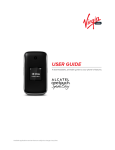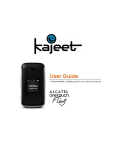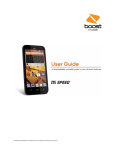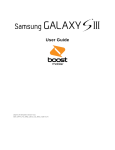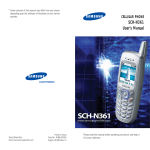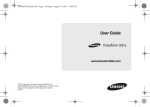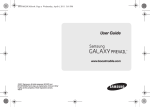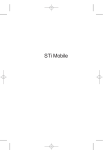Download Alcatel One Touch Fling Manual
Transcript
Available applications and services are subject to change at any time. Table of Contents Get Started 1 Your Phone at a Glance 1 Set Up Your Phone 2 Activation and Service 4 Create Your Account and Pick Your Plan 4 Activate Your Phone 5 Manage Your Account 5 Re-Boost 5 Additional Information 5 Set Up Voicemail Phone Basics 6 7 Your Phone’s Layout 7 Turn Your Phone On and Off 8 Navigate Through the Menus 9 Status Bar 9 Enter Text 10 Keypad Phone Calls Make Phone Calls 10 13 13 Call Using the Phone Dialer 13 Call from Recent History 13 Call from Contacts 13 Call Using a Speed Dial Number 14 Call Emergency Numbers 14 Receive Phone Calls 14 Voicemail 15 Voicemail Setup 15 Voicemail Notification 15 Retrieve Your Voicemail Messages 15 Phone Call Options 16 In-call Options 16 Caller ID 17 Conference Calling 17 Call Using a Speed Dial Number 18 i Recent History Contacts 18 19 View Contacts 19 Contacts List Options 20 Add a Contact 20 Create a Group 21 Save a Phone Number 22 Edit a Contact 22 Add or Edit Information for a Contact 22 Assign a Ringtone to a Contact 22 Delete a Contact 22 Remove a Member from a Group 23 Assign a Speed Dial Number to a Contact 23 Messaging 24 Text and Multimedia Messaging 24 Send a Text Message 24 Send a Multimedia Message (MMS) 25 Save and Resume a Draft Message 25 New Messages Notification 25 Manage Message Conversations 25 Music 27 Music Player Web and Data Launch a Web Connection 27 28 28 Learn to Navigate the Browser 28 Adjust Browser Settings 28 Download Games, Ringtones, and More 29 Access the Downloads Menus 29 Camera and Video 30 Open or Close the Camera 30 Take a Picture 30 Review Screen 30 Record Videos 30 View Pictures and Videos Using My Album 31 Open or Close My Album 31 View Pictures and Videos 31 Watch Video 32 Share Pictures and Videos 32 ii Send a Picture or Video by Multimedia Message 32 Tools and Calendar 33 Calendar 33 Add an Event to the Calendar 33 View an Event 33 Edit/Delete an Event 33 Alarm Clock 33 Calculator 34 Bluetooth 34 Turn Bluetooth On or Off microSD Card 34 34 Insert or remove a microSD Card 34 View microSD Card Memory 35 Format the microSD Card 35 Use the Phone’s microSD Card as a USB Drive 35 Transfer Files Between Your Phone and a Computer Settings 36 37 Airplane Mode 37 Display Settings 37 Wallpaper Settings Storage Settings Phone Memory 37 37 37 Location Services 37 Lock Phone 38 Language & Input Settings 38 Language Settings 38 Default Text Entry 38 Reset Phone 38 Accessibility Settings 38 Regulatory Information 40 Specific Absorption Rates (SAR) for Wireless Phones 40 FCC Radio Frequency Emission 40 Using Your Phone with a Hearing Aid Device 40 Warning Statements 42 Copyright Information 43 Index 44 iii Get Started The following topics give you all the information you need to set up your phone and service the first time. Your Phone at a Glance The following illustrations outline your phone’s primary external features and buttons. Get Started 1 Set Up Your Phone You must first install and charge the battery to begin setting up your phone. Get Started 2 Install the Battery: 1. Remove the back cover using the notch in the bottom-left corner of the phone. 2. Insert the external microSD card into the slot with the gold contact facing down. To remove the external microSD card, gently press and slide it out. 3. Insert the battery into the battery compartment, making sure the connectors align. Gently press down to secure the battery. Charge the Battery: 1. Insert the USB cable into the Charger/Accessory Jack on the bottom of the phone. Get Started 3 2. Insert the other end of the cable into the charging head, and then plug the charging head into an electrical outlet. You are advised to fully charge the battery ( ) . Charging status is indicated by the percentage on screen while the phone is powered off. The percentage increases as the phone is charged. Note: The charging status bar will not float if your battery is extensively consumed. To reduce power consumption and energy waste, when battery is fully charged, disconnect your charger from the plug; switch off Wi-Fi, GPS, Bluetooth or background-running applications when not in use; reduce the backlight time, etc. Activation and Service Before using your phone, you must set up your service with Boost Mobile. You will need your phone’s serial number (MEID), printed on a sticker inside the battery compartment. Create Your Account and Pick Your Plan Set up your Boost Mobile account. 1. From your computer, visit boostmobile.com/activate. 2. Enter your phone’s MEID and click start activation process. 3. Your phone’s MEID (serial number) is printed on the sticker located on the back of your phone in the battery compartment. This number can also be found on the bottom panel of the phone’s package. 4. Follow the remaining instructions to choose your plan and select a payment method. 5. Follow the activation instructions below and you’ll be able to start using your phone. Note: You can also activate by phone by calling 1-888-BOOST-4U (1-888-266-7848) from any other phone. Get Started 4 Activate Your Phone After setting up your account on boostmobile.com, simply turn your device on. Your device is designed to activate automatically. If you are swapping from another Boost Mobile device to a new one, be sure to turn off the old device before swapping the serial number (MEID). Once the MEID swap is complete, turn on the new device and the programming information will be pushed to your device automatically. Manage Your Account Access information about your account. You can: n Check your minutes. n Re-Boost® (add money to your account). n Change plans. n And more. From Your Computer n Log in with your wireless phone number and account PIN at boostmobile.com. From Any Other Phone n Boost Customer Care: 1-888-BOOST-4U (1-888-266-7848). Re-Boost Boost Mobile makes it easy to add money to your account. You decide exactly how and where you want to pay. Keep your account active by using your phone and adding money to your account. Pay with Cash Find an Authorized Re-Boost Retailer near you. Pick up a Re-Boost Card or recharge for as low as $10 at the register, where available. Set Up Worry-Free Payments with Auto Re-Boost℠ It’s the easiest way to make sure your account stays on and active. Use a credit card, debit card or bank account—whatever’s best for you. Visit boostmobile.com/reboost to get the details on all your Re-Boost options. Additional Information For more information about your Boost Mobile account, as well as other Boost Mobile services, visit us at: boostmobile.com. Get Started 5 Set Up Voicemail You should set up your voicemail and personal greeting as soon as your phone is activated. Always use a password to protect against unauthorized access. Your phone automatically transfers all unanswered calls to your voicemail, even if your phone is in use or turned off. 1. From the home screen, press MESSAGING (Left Soft Key) > Voicemail > Call Voicemail. 2. Follow the system prompts to: l Create your password. l Record your name announcement. l Record your greeting. Important: Voicemail Password – It is strongly recommended that you create a password when setting up your voicemail to protect against unauthorized access. Without a password, anyone who has access to your phone is able to access your voicemail messages. For more information about voicemail, see Voicemail. Get Started 6 Phone Basics Your phone is packed with features that simplify your life and expand your ability to stay connected to the people and information that are important to you. The following topics will introduce the basic functions and features of your phone. Your Phone’s Layout The illustrations and descriptions below outline your phone’s basic layout. Phone Basics 7 Key Functions Item Function Menu/OK Key Enter main menu/ Confirm an option Navigation Keys Press to go left/right/up/down to confirm an option Left Soft Key Messaging Right Soft Key Contacts List Send Key Recent Call (home screen)/ Answer/Send a call End Key Power on/Power off/ End a call/ Back to the Home screen 1 Key Long press to access Voicemail CAUTION! Inserting an accessory into the incorrect jack may damage the phone. Turn Your Phone On and Off The instructions below explain how to turn your phone on and off. Phone Basics 8 Turn Your Phone On/Off n Press and hold . Your screen remains blank while your phone is off (unless the battery is charging). Navigate Through the Menus The navigation keys on your phone lets you scroll through onscreen items. To navigate through a menu, press up or down using the navigation keys. Select Menu Items As you navigate through the menu, menu options are highlighted. Select any option by highlighting it and pressing. If the option is numbered, you can select it by pressing the corresponding number on the phone’s keypad. Back Up Within a Menu n To go to the previous menu, press n To return to the home screen, press . . Status Bar The status bar at the top of the home screen provides phone and service status information on the right side and notification alerts on the left. Status Icons Icon Status Bluetooth® active Airplane Mode Earphone Location on Vibrate Silent Bluetooth Network (full signal) Phone Basics 9 Icon Status Network (no signal) Network (roaming) 3G (data service) Alarm set Battery (charging) Battery (fully charged) Notification Icons Icon Notification Missed call New message New Voice Mail Music playing Event Alarm Enter Text You can type on your phone using the keypad. Keypad Your phone provides a convenient keypad to enter letters, numbers, and symbols whenever you are prompted to enter text. Phone Basics 10 1. From a screen where you can enter text, press OPTIONS (Right Soft Key) to change the text mode. (If you are in the message entry screen, press OPTIONS [Right Soft Key] > Text Mode.) 2. Select one of the following options: l T9Word to enter text using a predictive text system that reduces the number of key presses required while entering a word. l Abc to enter characters by using the alphabet mode. l 123 to enter numeric characters. l Symbols to enter symbols. l Smileys to enter smile icons. l Text Settings to display the text entry settings menu (if applicable). Number Function 1 1, commonly-used symbols 2 a, b, c, A, B, C, 2 Phone Basics 11 Number Function 3 d, e, f, D, E, F, 3 4 g, h, i, G, H, I, 4 5 j, k, l, J, K, L, 5 6 m, n, o, M, N, O, 6 7 p, q, r, s, P, Q, R, S, 7 8 t, u, v, T, U, V, 8 9 w, x, y, z, W, X, Y, Z, 9 0 0 * *, change input methods # #, insert a space Phone Basics 12 Phone Calls With Boost Mobile service and your phone’s calling features, you can enjoy clear phone calls across the country. Make Phone Calls There are several convenient ways to place calls from your phone. Call Using the Phone Dialer The most “traditional” way to place a call is by using the phone’s dialpad. 1. From the home screen, press the number keys on the dialpad to enter the phone number. 2. Press to call the number. 3. To end the call, press . Call from Recent History The Recent History menu lets you quickly place calls to recent incoming, outgoing, or missed numbers. 1. From the home screen, press to display the call history. 2. Select the number, and press again to place a call. Call from Contacts You can place phone calls directly from entries in your Contacts list. Phone Calls 13 1. From the home screen, press CONTACTS (Right Soft Key) to display the Contacts list. 2. Highlight a contact and then press to place a call. Call Using a Speed Dial Number Speed dial numbers let you dial numbers by pressing and holding a single number on the dialpad. From the home screen, enter the speed dial number, press to place a call. Call Emergency Numbers You can place calls to 9-1-1 even if the phone’s screen is locked or your account is restricted. To call the 9-1-1 emergency number: n From the home screen, press “9-1-1” and then press . Enhanced 9-1-1 (E 9-1-1) Information This phone features an embedded Global Positioning System (GPS) chip necessary for utilizing E 9-1-1 emergency location services where available. When you place an emergency 9-1-1 call, the GPS feature of your phone seeks information to calculate your approximate location. Depending on several variables, including availability and access to satellite signals, it may take up to 60 seconds or more to determine and report your approximate location. Important: Always report your location to the 9-1-1 operator when placing an emergency call. Some designated emergency call takers, known as Public Safety Answering Points (PSAPs), may not be equipped to receive GPS location information from your phone. Receive Phone Calls The following information lets you know how to answer incoming calls, mute the ringer on incoming calls, reject incoming calls, and more. When you receive a phone call from a contact, the Incoming call screen appears and displays the caller ID icon, name, and phone number of the calling party. When you receive a phone call from someone who is not stored, only the default caller ID icon and phone number appear on the Incoming call screen. Note: If your phone is turned off, all calls automatically go to voicemail. Answer an Incoming Call n Press the Menu/OK Key to answer the call. Phone Calls 14 Mute the Ringing Sound To mute the ringer without rejecting the call, press the Volume Down Button. Reject an Incoming Call n Press the End/Power Key to reject an incoming call and send the caller to voicemail. Reject a Call and Send a Text Message You can reject an incoming call and automatically send a text message to the caller. n Press Ignore with Text Message to ignore the call and send a text message to the caller. Voicemail The following topics outline your phone’s voicemail service. Voicemail Setup You should set up your voicemail and personal greeting as soon as your phone is activated. n For information on setting up your voicemail, see Set Up Voicemail. Voicemail Notification There are a couple of different ways your phone alerts you to a new voicemail message. n By sounding the assigned ringer type. n By displaying within the Notifications area of the Status bar when a single new unheard voicemail message is received. Note: When you are off network, you may not receive notification of new voicemail messages. It is recommended that you periodically check your voicemail by dialing 1 + area code + your wireless phone number. Note: Your phone accepts messages even when it is turned off. However, your phone notifies you of new messages only when it is turned on and you are in a network service area. Retrieve Your Voicemail Messages You can review your messages directly from your wireless phone (using either traditional voicemail) or from any other press-tone phone. Use Traditional Voicemail to Access Your Messages 1. Touch and hold . If prompted, enter your voicemail password. 2. Follow the voice prompts to listen to and manage your voicemail messages. Phone Calls 15 Use Another Phone to Access Messages 1. Dial your wireless phone number. 2. When your voicemail answers, press the asterisk key on the phone (*). 3. Enter your password. Tip: You can restore messages you have sent to the trash folder. Phone Call Options Your phone application provides many useful features and options to help you make the most of your calling experience. In-call Options While you’re on a call, you will see a number of onscreen options. Select a feature by pressing the corresponding keypad number or highlight the option and then press . n Speaker On: Route the phone’s audio through the speaker (On) or through the earpiece (Off). l Activate Speaker to route the phone’s audio through the speaker. (You can adjust the speaker volume using the volume buttons.) l Deactivate Speaker to use the phone’s earpiece. n Mute: Mute the microphone during an active call. Press again to unmute the microphone. n Add New Contacts: Add a new contact or update existing. n Contact Details: View detailed information of the incoming number. n Main menu: Display the main menu list. Phone Calls 16 n 3-Way Call: Initiate a 3-way conference call. n Contacts: Display your contacts list. n Voice Memo: Create a new memo while remaining on the call. Warning: Because of higher volume levels, do not place the phone near your ear while using speakerphone. Note: If Mute is activated, the speaker mode is deactivated. Caller ID Caller ID identifies a caller before you answer the phone by displaying the number of the incoming call. If you do not want your number displayed when you make a call, call Boost customer care to permanently block your number. Conference Calling With conference calling, also known as 3-way calling, you can talk to two people at the same time. When using this feature, the normal airtime rates will be charged for each of the two calls. 1. On the Phone screen, enter a number and press CONTACTS). (or place a call from Recent History or 2. Once you have established the connection, press OPTIONS (Right Soft Key) > 3-Way Call, and then dial the second number (or place the call from Recent History or CONTACTS). 3. This puts the first caller on hold and dials the second number. 4. Press TALK to join calls. Your conference call is now in session. 5. To end the three-way call, press Phone Calls . 17 Note: If one of the people you called hangs up during your call, you and the remaining caller stay connected. If you initiated the call and are the first to hang up, all callers are disconnected. Call Using a Speed Dial Number You can store up to 99 numbers in your phone’s speed dial memory to make contacting friends and family easier. You must have already assigned a speed dial number to an existing phone number. To use speed dial: n From the home screen, enter a speed dial number and then press n To end the call, press . . Recent History The Recent History lists all recent incoming, outgoing, and missed calls. View Recent History n From home screen, press , or press and then select Call History. Recent History Options n To make a call from the call log, select the number and press again. For additional options, press OPTIONS (Right Soft Key): n New group n Contact details n Delete n Delete All Phone Calls 18 Contacts Your phone’s Contacts help you stay in touch with family, friends, and colleagues by keeping track of all their contact information. The following topics explain how to use your phone’s Contacts. Personal Contacts Entries– Entries for an individual. Your phone can store up to 600 personal Contacts entries. Each entry can contain up to 7 phone numbers, and 3 email addresses, 3 IM addresses, and 3 Web addresses. Group Contacts Entries – Entries that contain more than one personal Contacts entry. Your phone can store up to 25 Group Contacts entries. Each group entry can contain up to 40 members. View Contacts You can view and create contacts on your phone. To access Contacts: n From the home screen, press CONTACTS (Right Soft Key). – or – From the home screen, press > Go to Contacts. l Contacts List: The Contacts list displays all contacts currently stored in your phone. l Add News: Press to add a new contact or new group. Contacts 19 Contacts List Options From contact list you can find various options listed below. n Send Msg: Send message to contact(s). n New Group: Create a new a group for contacts(s). n Edit Contact: Edit contact information. n Delete Contact: Delete the contact you select. n Delete All: Delete all contacts in the list. n Contact History: View call history. n Send Contact: Send contact via Bluetooth, etc. n Set as Secret/Show Secret: Hide/Unhide your contact from contact list. n Settings: View more options such as set speed numbers, show secret, My Name Card, Services, and ICE (In Case of Emergency). Add a Contact You can add contacts and enter details such as name, phone numbers, email addresses, mailing addresses, and more. 1. From the home screen, press CONTACTS (Right Soft Key) > Add New > New Contact. 2. Use the keypad to enter contact information you want, including: l Name l Phone Number l Email Address l IM Address l Website URL l Location - Press to select and enter an address. l Ringtone l Birthday l Memo l Job Title Contacts 20 l Company Create a Group You can create a group by assigning personal Contacts entries as members and then naming the new group. Each group entry can contain up to 40 members for sending messages. 1. From the home screen, press CONTACTS (Right Soft Key) > OPTIONS > New Group. 2. Press START (Left Soft Key), mark the check box to select contacts for group, press Continue, create a name for group, then press to save. Contacts 21 Save a Phone Number You can save a phone number to Contacts directly from Recent History or Call History. 1. From the home screen, press . 2. Highlight a phone number and press OPTIONS > Save Contact. 3. To add the number to an existing contact, select Existing Contacts. To add a new contact, select New Contacts. 4. For an existing contact, Press the contact name, select a number type for the new number, and then press Done. 5. For a new contact, enter the name and any additional information, and then press Done. Edit a Contact Once you’ve added a contact, you can add or edit any of the information in the entry, customize with a unique ringtone, and more. Add or Edit Information for a Contact Use the Edit contact menu to add or edit information for an existing contact. 1. From the home screen, press CONTACTS (Right Soft Key). 2. Select a contact to display it, and then press OPTIONS > Edit Contact. Assign a Ringtone to a Contact Know who’s calling without looking at your phone by assigning a specific ringer to a contact. 1. From the home screen, press CONTACTS (Right Soft Key). 2. Select a contact to display it, and then press OPTIONS > Edit Contact. 3. Highlight and select Ringtone field then select an available ringtone. 4. Press Play, you will hear a sample. 5. Press > Done to assign the ringtone. Delete a Contact You can delete a contact from the contacts details page. 1. From the home screen, press CONTACTS (Right Soft Key). 2. Press a contact to display it, and then press OPTIONS > Delete Contact. 3. Press DELETE (Left Soft Key) to confirm. Contacts 22 Remove a Member from a Group You can remove a member from a current Group. 1. From the home screen, press CONTACTS (Right Soft Key). 2. Highlight a group and then press OPTIONS (Right Soft Key) > Edit Group. 3. Highlight a contact and then press OPTIONS (Right Soft Key) > Remove From Group. Assign a Speed Dial Number to a Contact Your phone can store up to 99 phone numbers in speed dial locations. To assign a speed dial number: 1. From the home screen, press CONTACTS (Right Soft Key). 2. Press OPTIONS (Right Soft Key) > Settings > Speed Numbers. 3. Enter or select a number to assign the speed dial location. 4. Select a contact to be added to the speed dial location. Note: If you assign a number to an already in-use speed dial location, the new phone number will automatically replace the previously assigned speed dial. Contacts 23 Messaging Send messages to your family and friends with text messaging (SMS) and multimedia messaging (MMS). Text and Multimedia Messaging With Text Messaging (SMS), you can send and receive instant text messages between your wireless phone and another messaging-ready phone. Multimedia messages, or MMS, can contain text and pictures, recorded voice, audio or video files. See your service plan for applicable charges for messaging. Send a Text Message Quickly compose and send text messages from your phone. 1. From the home screen, press MESSAGING (Left Soft Key). 2. On the Messaging screen, press Send Message. Select a contact or New Address to send message and the Compose screen opens. 3. To enter a recipient, select a contact or press NEW ADDRESS (Right Soft Key). l To enter multiple recipients, press MULTIPLE (Left Soft Key). When you have selected all the message recipients, press CONTINUE (Left Soft Key). 4. Compose your message. Note: A counter appears above the SEND button to tell you how many characters you have entered and how many characters are left. Once you go over the 160-character limit, a new message is created but automatically joined into one when received. 5. Review your message and then press SEND (Left Soft Key) to send the text message. Messaging 24 Send a Multimedia Message (MMS) When you need to add a little more to a text message, you can send a multimedia message (MMS) with pictures, voice recordings, audio or video files. 1. From the home screen, press MESSAGING (Left Soft Key). 2. On the Messaging screen, press Send Message. 3. To enter a recipient, select a contact or press NEW ADDRESS (Right Soft Key). l To enter multiple recipients, press MULTIPLE (Left Soft Key). When you have selected all the message recipients, press CONTINUE (Left Soft Key). 4. Compose your message. 5. Select . 6. In the Attach window, select from the following file attachments: l My Albums. Select pictures or videos from My Albums to attach. l Take a new picture. Take a new picture as attachment. l Take a new video. Take a new video as attachment. l Voice. Add an existing or new voice as attachment. Save and Resume a Draft Message A Message can be saved or resumed after composing. n While composing a text or multimedia message, press OPTIONS > Save As Draft to automatically save your message as a draft. New Messages Notification Depending on your notification settings, the phone will play a ringtone, vibrate, or display the message briefly in the status bar when you receive a new text or multimedia message. Manage Message Conversations Text and multimedia messages that are sent to and received from a contact (or a number) are grouped into conversations or message threads in the Messaging screen. Threaded text or multimedia messages let you see exchanged messages (similar to a chat program) with a contact on the screen. Read a Text Message 1. On the Messaging screen, select the text message or message thread to open and read it. 2. If you have a new message notification, press OPTIONS to reply, forward or delete it. 3. To return to the Messaging screen from a text message thread, press the BACK key Messaging . 25 View a Multimedia Message (MMS) 1. From the home screen, press MESSAGING (Left Soft Key). 2. On the Messaging screen, press a multimedia message or message thread to open it. 3. Select the attachment to open it. Reply to a Message 1. From the home screen, press MESSAGING (Left Soft Key). 2. On the Messaging screen, press a text or multimedia message thread to open it. 3. Press Reply, enter your content, and then press SEND. Delete a Message Thread 1. From the home screen, press MESSAGING (Left Soft Key). 2. On the Messaging screen, select the message thread that you want to delete. 3. Press Options > Delete message. 4. When prompted to confirm, press Yes. Delete Multiple Message Threads 1. From the home screen, press MESSAGING (Left Soft Key). 2. On the Messaging screen, press Options > Delete Multiple. 3. Mark the check box to select the message threads you want to delete, press DONE and then press Yes to confirm. 4. Press Select All and then Clear All to delete all messages. Delete a Single Message 1. While viewing a message thread, enter the message that you want to delete. 2. Press Delete message on the options menu. 3. When prompted to confirm, press Yes. Messaging 26 Music Listen to your favorite music using your phone's Music Player application. Music Player Your phone’s built-in music player app lets you listen to and organize music files you have loaded into your phone’s microSD card. Note: For information about loading music onto your phone, see Transfer Files Between Your Phone and a Computer. Listen to Music Using the Player 1. From the home screen, press > Player . 2. To adjust the volume, press the Volume up or Volume down keys. Music 27 Web and Data Your phone’s data capabilities let you wirelessly access the Internet. The following topics address your phone’s data connections and the built-in Web browser. Your phone supports a 1X RTT network. Launch a Web Connection Launching a Web connection is as simple as opening the browser on your phone. 1. From the home screen, press page.) > Web. (Your data connection starts and you see the home 2. To scroll through the screen, use the Up and Down Navigation keys. 3. To exit the Web at any time, simply press . Note: The Browser automatically launches when a Web link is selected from a text message. Learn to Navigate the Browser Navigating through menus and websites during a data session is easy once you have learned a few basics. n To scroll through Web items, press the Up or Down Navigation keys. n To access the Web menu list, press Navigation (Left Soft Key). n To return to the previous page, press Navigation (Left Soft Key) and then select the Back button. n To move to the next page, press Navigation (Left Soft Key) and then select the Forward button. Options available within the browser menu include: n Bookmarks: Use bookmarks when you want to leave a page and visit it later. n Browsing history: Display recently accessed pages. n Offline pages: Display offline pages. n Add this page to Bookmarks: Add the current page to your Bookmarks. n Send this page to a friend: Send the current page address to a friend via text message. Adjust Browser Settings You can control many of the settings for your browser through the browser settings menu. Web and Data 28 n From any open Web page, press Options (Right Soft Key) > Browser settings. l Startup page: Set startup page. l Automatic Overview Mode: Turn on/off Automatic Overview Mode. l Default zoom size: Select automatic or customized zoom value. l Do not show images/Show images: Display or Hide images on the Web page. l Icon row: Display or hide the area showing icons. l Popups: Allow or block pop-ups. l Clear private data: Clear cookies, cache, history, or stored passwords. l Advanced: View more settings such as page information, browser information, disable JavaScript, etc. Download Games, Ringtones, and More You have access to a dynamic variety of downloadable content, such as ringtones and applications. (Additional charges may apply.) Follow the steps below to access and download content. Access the Downloads Menus Access the download menus to download content. 1. From the home screen, press > Downloads. 2. Select Boost Mobile Music Store to download Ringtones and Ringback tones. Web and Data 29 Camera and Video You can use your phone's camera or camcorder to take and share pictures and videos. Your phone comes with a 2-megapixel camera with an autofocus feature that lets you capture sharp pictures and videos. Open or Close the Camera You can open the camera through the applications list and close it from the camera menu. In addition to using the applications list to open the camera, you may be able to launch the camera from within other applications such as Contacts or Messaging. Open the Camera You can take and view pictures using your phone's camera. n To open the camera in picture mode and take pictures, press > Photos > Camera. Close the Camera Close the camera when you are finished taking pictures. n On the camera screen, press or . Take a Picture The following topics teach you how to take pictures with your phone’s camera. 1. From the home screen, press 2. Press > Photos > Camera. to take the picture. 3. Select OPTIONS to do what you want with the picture you’ve just taken. Review Screen After capturing a picture or video, you can access options such as send, assign, delete, or review album. Record Videos Record videos using your phone’s video camera. Camera and Video 30 1. From the home screen, press > Photos > Camcorder. 2. If prompted, choose a recording mode: Video Mail or Long Video. 3. Press to start capturing video. 4. Press again to stop recording. 5. Press OPTIONS (Right Soft Key) to Send, Play, Delete, or Review the video. View Pictures and Videos Using My Album Using My Album, you can view pictures and watch videos that you’ve taken with your phone’s camera, downloaded, or copied onto your storage card or phone memory. Open or Close My Album Your pictures and videos are organized by albums for easy viewing. Open My Album 1. From the home screen, press > Photos > My Album. 2. Select an image to view. Close My Album n To close My Album and return to the home screen, press . View Pictures and Videos You can access and view all your stored pictures and videos from My Album. Camera and Video 31 1. From the home screen, press > Photos > My Album. 2. Select an image or video to view. Note: If you want to select another image or video, press to return to the My Album. Watch Video Use the onscreen controls to play, pause, fast-forward or rewind the video. 1. From the home screen, press > Photos > My Album. 2. Select an album containing a video you want to watch, and then select an image to view the video. 3. Use the onscreen icons to control your playback. Share Pictures and Videos The Photos application lets you send pictures and videos using multimedia messages. Send a Picture or Video by Multimedia Message Multimedia Messaging (MMS) lets you send pictures and videos using your phone’s messaging app. Although you can send several pictures or videos in a multimedia message, it may be better to just send one at a time, especially if the files are large in size. 1. From the home screen, press > Photos > My Album. 2. Select the album that contains the pictures or videos you want to share. 3. Select the pictures or videos you want to share. 4. Press SEND (Left Soft Key). 5. Select a contact or enter a new recipient address. 6. Compose your message and then press SEND (Left Soft Key). Camera and Video 32 Tools and Calendar Learn how to use many of your phone’s productivity-enhancing features. Calendar Use Calendar to create and manage events, meetings, and appointments. Your Calendar helps organize your time and reminds you of important events. Add an Event to the Calendar Add events to your calendar directly from the Calendar application. 1. From the home screen, press > Tools > Calendar. 2. Press OPTIONS > Add New Event. 3. Fill in all required information for this new event. 4. When done, press SAVE (Left Soft key) to save. View an Event View detailed information about your Calendar events. 1. From the home screen, press > Tools > Calendar. 2. Select a date that has an event. 3. Select an event to view details. Edit/Delete an Event Use Calendar to edit or delete an existing event. 1. From the home screen, press > Tools > Calendar. 2. Select a date that has an event. 3. To edit an event, select the event and then press EDIT (Right Soft Key); to delete the event, press DELETE (Left Soft Key). Event Reminders If you have set at least one reminder for an event, the upcoming event icon will appear. n Select View Now or Dismiss. Alarm Clock Set multiple alarms using your phone’s Alarm Clock app. Tools and Calendar 33 1. From the home screen, press > Tools > Alarm. 2. If you haven’t created any alarm, press CREATE NEW (Left Soft Key). 3. Fill in all required information for this alarm. 4. When done, press DONE (Left Soft Key). Calculator Your phone’s convenient built-in calculator lets you perform basic mathematical equations. n From the home screen, press > Tools > Calculator. l Enter a number, select the type of operation to be performed using the Navigation keys, and enter the second number, then press the key to display the result. l Once an operation is complete, you can select CLEAR to clear numbers and carry out a new operation. Bluetooth Bluetooth is a short-range communications technology that allows you to connect wirelessly to a number of Bluetooth devices, such as headsets and hands-free car kits, and Bluetooth-enabled handhelds, computers, printers. The Bluetooth communication range is usually approximately 30 feet. Turn Bluetooth On or Off Bluetooth can be turned on and off from the Tools menu. n From the home screen, press > Tools > Bluetooth. To pair and use your phone with a Bluetooth-enabled device: 1. From the home screen, press > Tools > Bluetooth > Add New. 2. Select the device you wish to pair with and press > YES. 3. (Optional) Edit the device name and then press SAVE (Left Soft Key). Note: Turn off Bluetooth when not in use to conserve battery power. microSD Card A microSD™ card is an optional accessory that allows you to store images, videos, music, documents, and voice data on your phone. Insert or remove a microSD Card Insert the external microSD card into the slot with the gold contact facing down. To remove Tools and Calendar 34 the external microSD card, gently press and slide it out. Note: You can easily damage the microSD card by improper operation. Please be careful when inserting, removing, or handling the microSD card. Note: Make sure your battery is fully charged before using the microSD card. Your data may become damaged or unusable if the battery runs out while using the microSD card. View microSD Card Memory The Storage settings menu gives you access to your microSD card memory information. n With the microSD card inserted, press > Tools > Mass Storage > Memory Info > Memory Card. (The total and available memory space will be displayed.) Format the microSD Card Formatting a microSD card permanently removes all files stored on the card. 1. From the home screen, press > Tools > Mass Storage > Format Memory Card. 2. Press Yes to confirm. Note: The formatting procedure erases all the data on the microSD card, after which the files CANNOT be retrieved. To prevent the loss of important data, please check the contents before you format the card. Use the Phone’s microSD Card as a USB Drive To transfer music, pictures, and other files from your computer to your phone’s microSD card, you need to set the phone’s microSD card as a USB drive. For more details about transferring content between your phone and a computer, see Transfer Files Between Your Phone and a Computer. Tools and Calendar 35 1. Connect the phone to your computer using the supplied USB cable. 2. From the home screen, press > Tools > Mass Storage > Connect to PC. 3. On your computer, the connected phone is recognized as a removable disk. Navigate to this removable disk and open it. 4. Do one of the following: l Copy files from the computer to the root folder on the phone’s storage card. l Copy files from the phone’s storage card to a folder on your computer. 5. Press to disconnect the phone from the computer. Note: The phone will not recognize the microSD card when it is connected to a computer as a disk drive. You will not be able to use some of the phone’s applications such as the camera or Music. Transfer Files Between Your Phone and a Computer You can use the supplied USB connector to connect your phone directly to your computer and transfer music, pictures, and other content files. For example, if you have a music album stored on your computer that you want to listen to on your tablet with the music player or any other app, just attach your phone to the computer and copy the files to the music folder. 1. Connect your phone to your computer using the supplied USB/charging cable. 2. From the home screen, press > Tools > Mass Storage > Connect to PC. 3. Select a folder (for example, Music for songs and albums) and copy files to it from your computer. 4. When you are done, press Tools and Calendar to disconnect your phone from your computer. 36 Settings The following topics provide an overview of items you can change using your phone’s Settings menus. Airplane Mode Airplane Mode allows you to use many of your phone’s features, such as Camera and Music, when you are on an airplane or in any other area where making or receiving calls or data is prohibited. When you set your phone to Airplane Mode, it cannot send or receive any calls or access online information. To turn Airplane Mode on or off: n From the home screen, press > Settings > Others > Airplane Mode. Display Settings Adjusting your phone’s display settings not only helps you see what you want, it can also help increase battery life. Wallpaper Settings Select and assign your phone’s background wallpaper. 1. From the home screen, press > Settings > Display > Main Screen > Wallpaper. 2. Select an option to set the wallpaper. Storage Settings The Storage settings menu lets you manage internal storage on your phone and provides options for your microSD card. Phone Memory The internal storage menu lets you view your phone’s internal storage capability and available space. 1. From the home screen, press > Tools > Mass Storage > Memory Info > Phone. 2. View your phone’s memory storage total space and space used by specific features. Location Services Use your Location settings menu to enable location detection. 1. From the home screen, press > Settings > Location. 2. Select On to allow the network to detect your position using GPS. Settings 37 Note: Turning location off will disable the GPS capability of your phone for all purposes except 9-11. GPS support for E 9-1-1 service is not available in all areas. Lock Phone Lock phone settings let you protect your phone and data from unauthorized access. It is recommended you frequently change your password to ensure the safety of your phone and personal data. 1. From the home screen, press > Settings > Lock Phone. 2. Enter security code with 4 digits. Language & Input Settings Your phone’s language and input settings let you select a language for the phone’s menus and keypads, select and configure keypad settings. Language Settings The language settings menu lets you select an onscreen language and add custom words to your phone’s user dictionary. 1. From the home screen, press > Settings > Others > Language. 2. Press an available language (English or Español). Default Text Entry The text entry settings let you select a variety of choices while entering text. 1. From the home screen, press > Settings > Others > Text Entry. 2. A variety of text entry options are available. Reset Phone Your phone’s reset menu erases all data from the phone’s application storage, including messages, phones calls, downloaded application, etc. Tip: Before performing a factory data reset on your phone, you may want to remove the microSD card to avoid losing any data you may have stored on it. 1. From the home screen, press > Settings > Reset/Delete. 2. Enter security code with 4 digits. Accessibility Settings The Accessibility menu lets you enable and manage accessibility-related applications. To access the menu, please follow below instructions: Settings 38 n From the home screen, press > Settings > Accessibility. l Voice Guide: Press to turn on/off Voice Guide. l TTY: Press to select TTY functions or turn off TTY. l Font Size: Select font size. l Hearing AID: Turn on hearing aid to reduce unacceptable noise. Settings 39 Regulatory Information The following topics provide important regulatory information. Specific Absorption Rates (SAR) for Wireless Phones The SAR value corresponds to the relative amount of RF energy absorbed into the head of a user of a wireless handset. The SAR value of a phone is the result of an extensive testing, measuring and calculation process. It does not represent how much RF the phone emits. All phone models are tested at their highest value in strict laboratory settings. But when in operation, the SAR of a phone can be substantially less than the level reported to the FCC. This is because of a variety of factors including its proximity to a base station antenna, phone design and other factors. What is important to remember is that each phone meets strict federal guidelines. Variations in SARs do not represent a variation in safety. All phones must meet the federal standard, which incorporates a substantial margin of safety. As stated above, variations in SAR values between different model phones do not mean variations in safety. SAR values at or below the federal standard of 1.6 W/kg are considered safe for use by the public. The highest reported SAR values of the ALCATEL ONETOUCH FLING are: Head: 1.075 W/kg (1g) Body-worn: 1.473 W/kg (1g) For body-worn operation, this device has been tested and meets the FCC RF exposure guidelines when used with an accessory that contains no metal and that positions the handset a minimum of 1.5cm from the user’s body. FCC Radio Frequency Emission This phone meets the FCC Radio Frequency Emission Guidelines. FCC ID number: RAD506 More information on the phone’s SAR can be found from the following FCC website: http://fcc.gov/oet/ea/ Using Your Phone with a Hearing Aid Device A number of Boost phones have been tested for hearing aid device compatibility. When some wireless phones are used with certain hearing devices (including hearing aids and cochlear implants), users may detect a noise which can interfere with the effectiveness of the hearing device. Regulatory Information 40 Some hearing devices are more immune than others to this interference noise, and phones also vary in the amount of interference noise they may generate. ANSI standard C63.19 was developed to provide a standardized means of measuring both wireless phone and hearing devices to determine usability rating categories for both. Ratings have been developed for mobile phones to assist hearing device users find phones that may be compatible with their hearing device. Not all phones have been rated for compatibility with hearing devices. Phones that have been rated have a label located on the box. Your ALCATEL ONETOUCH FLING has an M4/T4 rating. These ratings are not guarantees. Results will vary depending on the user’s hearing device and individual type and degree of hearing loss. If a hearing device is particularly vulnerable to interference noise; even a phone with a higher rating may still cause unacceptable noise levels in the hearing device. Trying out the phone with your hearing device is the best way to evaluate it for your personal needs. M-Ratings: Phones rated M3 or M4 meet FCC requirements for hearing aid compatibility and are likely to generate less interference to hearing devices than unrated phones. (M4 is the better/higher of the two ratings.) T-Ratings: Phones rated T3 or T4 meet FCC requirements and are likely to be more usable with a hearing device’s telecoil (“T Switch” or “Telephone Switch”) than unrated phones. (T4 is the better/higher of the two ratings. Note that not all hearing devices have telecoils in them.) Note: New Technologies, Including Wi-Fi. This phone has been tested and rated for use with hearing aids for some of the wireless technologies that it uses. However, there may be newer wireless technologies (including Wi-Fi) used in this phone that have not been tested for use with hearing aids. Hearing aid devices may also be measured for immunity to interference noise from wireless phones and should have ratings similar to phones. Ask your hearing healthcare professional for the rating of your hearing aid. Add the rating of your hearing aid and your phone to determine probable usability: n Any combined rating equal to or greater than six offers excellent use. n Any combined rating equal to five is considered normal use. n Any combined rating equal to four is considered usable. Thus, if you pair an M3 hearing aid with an M3 phone, you will have a combined rating of six for “excellent use.” This is synonymous for T ratings. It is further suggested you experiment with multiple phones (even those not labeled M3/T3 or M4/T4) while in the store to find the one that works best with your hearing aid device. Should you experience interference or find the quality of service unsatisfactory after purchasing your phone, promptly return it to the store. More information about hearing aid compatibility may be found at: fcc.gov, fda.gov, and accesswireless.org. This equipment complies with the hearing aid compatibility technical requirements of Section 20.19 of the rules. HAC Ratings: M4 T4 -2011. Regulatory Information 41 Warning Statements THIS DEVICE COMPLIES WITH PART 15 OF THE FCC RULES. OPERATION IS SUBJECT TO THE FOLLOWING TWO CONDITIONS: (1) THIS DEVICE MAY NOT CAUSE HARMFUL INTERFERENCE, AND (2) THIS DEVICE MUST ACCEPT ANY INTERFERENCE RECEIVED, INCLUDING INTERFERENCE THAT MAY CAUSE UNDESIRED OPERATION. The user manual for an intentional or unintentional radiator shall caution the user that changes or modifications not expressly approved by the party responsible for compliance could void the user’s authority to operate the equipment. Note: THE GRANTEE IS NOT RESPONSIBLE FOR ANY CHANGES OR MODIFICATIONS NOT EXPRESSLY APPROVED BY THE PARTY RESPONSIBLE FOR COMPLIANCE. SUCH MODIFICATIONS COULD VOID THE USER’S AUTHORITY TO OPERATE THE EQUIPMENT. Note: This equipment has been tested and found to comply with the limits for a Class B digital device, pursuant to part 15 of the FCC Rules. These limits are designed to provide reasonable protection against harmful interference in a residential installation. This equipment generates, uses and can radiate radio frequency energy and, if not installed and used in accordance with the instructions, may cause harmful interference to radio communications. However, there is no guarantee that interference will not occur in a particular installation. If this equipment does cause harmful interference to radio or television reception, which can be determined by turning the equipment off and on, the user is encouraged to try to correct the interference by one or more of the following measures: n Reorient or relocate the receiving antenna. n Increase the separation between the equipment and receiver. n Connect the equipment into an outlet on a circuit different from that to which the receiver is connected. n Consult the dealer or an experienced radio/TV technician for help. Regulatory Information 42 Copyright Information ©2014 Boost Worldwide, Inc. Boost, the Logo, Re-Boost and Boost Mobile are trademarks of Boost Worldwide, Inc. ALCATEL is a trademark of Alcatel-Lucent used under license by TCT Mobile Limited. ONETOUCH and FLING are trademarks of TCT Mobile Limited. Other marks are property of their respective owners. Copyright Information 43 Index 3 Contacts List 19 Options 20 Copyright Information 43 A D 3-way Calling 17 Accessibility 38 Account Information 5 Activation 4 Activate Your Phone 5 Create Your Account and Pick Your Plan 4 Airplane Mode 37 Alarm Clock 33 Answer a Call 14 B Bluetooth 34 Turn on or off 34 Browser Navigate 28 Settings 28 E Emergency Numbers 14 Enhanced 9-1-1 (E 9-1-1) 14 Enter Text 10 Entertainment 30 F C Calculator 34 Calendar 33 Add an Event 33 Edit/Delete an Event 33 View an Event 33 Call Logs Make call from 13 Options 18 View 18 Caller ID 17 Camera 30 Open and Close 30 Review screen 30 Take a picture 30 Conference Calling 17 Contacts 19 Add a Contact 20 Assign a ringtone 22 Assign a Speed Dial Number 23 Create a Group 21 Delete 22 Edit 22 Make call from 13 Remove a Member from a Group 23 Save a phone number 22 Index Data 28 Default Text Input 38 Display Settings 37 Download Content 29 Menus 29 FCC Radio Frequency Emission 40 Files Transfer between phone and computer 36 G Gallery 31 Close 31 My Album 31 Open 31 View pictures and videos 31 Get Started 1 GPS Satellites 37 I In-call Options 16 Incoming Call Answer 14 Reject 15 K Keypad 10 L Language 38 Language & Input Settings 38 Location GPS satellites 37 44 Location Services 37 Lock Phone 38 M Manage Your Account 5 Messaging 24 Drafts 25 microSD Card 34-35 Format 35 Insert 34 View memory 35 MMS Send messages 25 Multimedia Messaging Share Pictures and Videos 32 Music 27 Music Player app 27 N Navigate Through the Menus 9 Notification Icons 10 Notifications 9-10 P Phone Dialer 13 Phone Basics 7 Phone Calls 13 Emergency numbers 14 Make calls 13 Options 16 Receive 14 Recent History 18 Using Call Logs 13 Using contacts 13 Using phone keypad 13 Using speed dial 14 Phone Illustration 1 Phone Layout (illustration) 7 Phone Memory 37 Phone Number Save to contacts 22 Pictures Share via Messaging 32 Take with camera 30 View 31 R Re-Boost 5 Regulatory Information 40 Index Reject Incoming Call 15 Reset Phone 38 Ringtone Assign to a contact 22 S Save a Phone Number 22 SD Card 34 Set Up Your Phone 2 Settings 37 Display 37 Language & Input 38 Wallpaper 37 Specific Absorption Rates 40 Speed Dialing 18 Status Bar 9 Status Icons 9 Storage Card 34 Storage Settings 37 T Text Entry 10 Text Input Default 38 Text Messaging Conversations 25 Notifications 25 Send messages 24 Tools 33 Turn Your Phone On and Off 8 Typing 10 U USB 35 Using Your Phone with a Hearing Aid Device 40 V Video Camera Record video 30 Videos Record 30 Share via Messaging 32 View 31 Watch 32 Voicemail 15 Notification 15 Retrieve messages 15 Set up 15 Setup 6 45 W Wallpaper 37 Warning Statements 42 Web 28 Launch a Connection 28 Index 46


















































